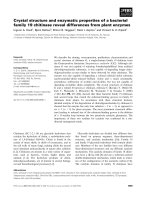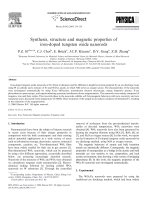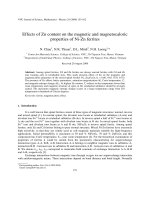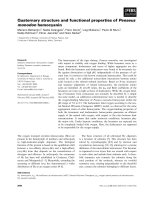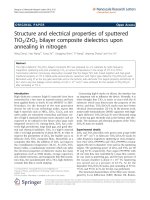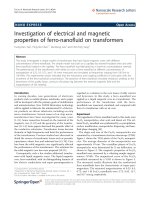Structure and magnetic properties of SrFe12O19/CoFe2O4 nanocomposite ferrite
Bạn đang xem bản rút gọn của tài liệu. Xem và tải ngay bản đầy đủ của tài liệu tại đây (1.09 MB, 10 trang )
VNU Journal of Science: Mathematics – Physics, Vol. 35, No. 2 (2019) 32-41
Original Article
Structure and Magnetic Properties of SrFe12O19/CoFe2O4
Nanocomposite Ferrite
Tran Thi Viet Nga1,*, Nguyen Thi Lan2, To Thanh Loan1, Hoang Ha1
1
International Training Institute for Materials Science (ITIMS) Hanoi University of Technology,
01 Dai Co Viet, Hanoi, Vietnam
2
Advanced Institute for Science and Technology (AIST) Hanoi University of Technology,
01 Dai Co Viet, Hanoi, Vietnam
Received 25 January 2019
Revised 23 May 2019; Accepted 28 May 2019
Abstract: Nanocomposite particles SrFe12O19/ CoFe2O4 were synthesized by sol-gel method. The
nanocomposites are formed at the calcining temperature around 850 oC in 5 hours. The phase
composition, surface morphology and magnetic properties of the nanocomposites were investigated
using XRD, SEM and VSM, respectively. The results show that the magnetic properties of
nanocomposite particles are strongly influenced by the molar ratios of the hard and soft phases and
particle size distributions. The samples with the mass ratio of Rm= SrFe12O19/ NiFe2O4 = 1/3 and 1/5
are characterized with a “bee waist” type hysteresis loop. While all the samples RV show an excellent
smooth hysteresis loop and a single – phase magnetization behavior. The coercivity decreases
significantly and the magnetization drastically increases with decreasing of volume ratio RV.
Keywords: nanocomposite, sol- gel method, exchange coupling.
1. Introduction
Nanocomposite magnetic materials consisting of soft and hard magnetic phases have become a hot
research topic in recent time because of potential applications in the fields of science and technology.
For example, magnetic micro electromechanical systems (MEMS) including microactuators, sensors,
recording heads and micro-motors, spins of electron devices apply in spin- valve read heads [1-4].
Theoretically, by combining high magnetic anisotropy of magnetically hard phase and the high
saturation magnetization of magnetically soft phase can enhance their magnetic properties. However,
________
Corresponding author.
Email address:
https//doi.org/ 10.25073/2588-1124/vnumap.4319
32
T.T.V. Nga et al. / VNU Journal of Science: Mathematics – Physics, Vol. 35, No. 2 (2019) 32-41
33
the magnetic properties of nanocomposite materials depend strongly on the grain size, structure and
morphology of phases, distribution of the magnetically hard and soft phases, and impurity. Numerous
efforts have recently been made into the fabrication of nanocomposite particles to enhance exchange
coupling interaction by controlling the particle size and distribution particles. A mong the hard materials
(NdFeB, SmCo5, FePt…), strontium ferrite (SrM) has high coercivity HC, large magneto- crystalline
anisotropy [5] and excellent chemical stability [6]. It is well known that CoFe 2O4 is a spinel ferrite,
which possesses higher saturation, remanent magnetization and coercivity compared with other spinel
ferrites (NiFe2O4, MnFe2O4, …) [7]. Therefore, in the exchange spring magnet, mixing of SrM- hard
phase and CoFe2O4 phase could utilize the superior magnetic properties of two phases. The recent
research work showed that the ferrite particles can be obtained via the chemical methods such as coprecipitation, hydrothermal [8, 9], sol–gel [10, 11]. Moreover, the ferrites can be successfully
synthesized at a relatively low temperature without subsequent sintering at high temperature. That may
be beneficial to control the growth of crystallites. So, we only need a relatively lower sintering
temperature to achieve the homogeneous ferrite particles and a strong exchange coupling. In this work,
SrFe12O19/CoFe2O4 nanocomposite have been prepared by sol- gel method.
2. Experiment
Synthesis of SrFe12O19 and CoFe2O4 powders
SrFe12O19 and CoFe2O4 nanopowders were synthesized separately by via sol-gel method. Fe(NO3)3
9H2O, Sr(NO3)2 and Co(NO3)26H2O were dissolved in deionized water to form an aqueous solution of
1M. The nitrates used to synthesize SrFe12O19 and CoFe2O4 were dissolved in deionized water with the
molar ratio Sr/Fe is 11.5 and Co/Fe is 2. Citric acid (AC) was then added into the solution at fixed [Sr2+
+ Fe3+]:AC and [Co2+ + Fe3+]: AC molar ratio of 1:3. NH4OH was used to adjust the pH to 1. After the
pH had been stabilized, the solution was stirred at 1000 rpm and gradually evaporated at 90 °C. As the
water evaporated, the remainder became highly viscous gels as a result of the chelation process. These
gels were dried at 90 °C for 24 h, and then heated at 450 °C (for SrFe12O19) and 200 oC (for CoFe2O4)
for 2 hours to eliminate the remaining residual water and other organic impurities (aerogels were
formed). To form the hexaferrite and spinel phase, the gels were calcined in air at 850°C for 5 hours.
Preparation of SrFe12O19 /CoFe2O4 nanocomposites
The first series of specimens SrFe12O19/CoFe2O4 nanopowders were synthesized using the aerogel
powders obtained previously. SrFe12O19 and CoFe2O4 aerogel powders were uniformly mixed with mass
ratios (Rm) of 1:1, 1:3, 1:5 and 1:7, denoted as Rm11, Rm13, Rm15 and Rm17, respectively. Then the
mixtures were pressed into platelets of 6 mm in diameter and sintered at 850 oC for 5 hours.
The second series of specimens, the SrFe12O19/CoFe2O4 nanocomposite powders were synthesized
by one step sol-gel method. Stoichiometric amounts of Fe(NO3)3. 9H2O, Sr(NO3)2, Co(NO3)2 were
dissolved completely in deionized water. In these processes, the ratio of Sr2+/Fe3+ and Fe3+/ Co2+ were
fixed at 11.5 and 2. The ratio RV of (Sr2+/Fe3+) : (Fe3+/Co2+) was fixed at 1:1, 1:3, 1:5 and 1:7. Citric acid
was then added into the solution at a fixed (Sr2+ + Fe3+ + Co2+)/AC volume ratio of 1/3. NH4OH in
aqueous form was added to the mixed solutions and the pH of the solutions was adjusted to about 1. The
mixtures were stirred at 1000 rpm and slowly evaporated at 90 oC to form gels. These gels were dried
at 90 oC for 24 h and then heated at 350 oC for 2 hours to eliminate the remaining residual water and
other organic impurities. An equal weight of the produced ferrite powders was compressed into
34
T.T.V. Nga et al. / VNU Journal of Science: Mathematics – Physics, Vol. 35, No. 2 (2019) 32-41
briquettes of 6 mm diameters and 3 g weight. The composites were annealed in air at 850 oC for 5 h.
The samples were marked as RV11, RV13, RV15 and RV17.
Characterization
The crystal structure and phases of the obtained samples were identified via X-ray powder
diffraction (XRD) using a Siemens D5000 diffractometer (CuKα radiation, λ = 1.54056 Å).
Morphological features and particle size were observed by scanning electron microscopy (SEM, JEOLJSM 7600F). The magnetic were measured using a vibrating sample magnetometer (VSM, Lakeshore
7410) with applied magnetic fields up to 10 kOe. Thermogravimetric analyses (TGA) were employed
to study thermal behavior using a Universal V2960T with a heating rate of 10 °C/min in air, whereas
pure alumina powder was used as the reference specimen.
3. Result and discussions
The TGA of gel precursor with RV = 1 are shown in the Fig. 1. The experiment was performed using
23.224 mg of gel precursor and a heating of 10 oC/ min in static air. The first exothermic peak at
approximately 152 oC was attributed to the decomposition of NH4NO3 to liberate NO, O2, and H2O and
the weight loss of 45%. The second exothermic peak at approximately 230 oC showed the decomposition
of the remaining unreactive organic material induced by excess citric and weight loss of 67.4% (Fig. 1
a). At the approximately 549 oC and 730 oC, the weight loss about 70.55% (Fig. 1 b). At higher
temperature, the weight has not decreased. Based on the results obtained from the thermal analysis of
the composite precursor (Fig. 1), we choose the temperature of 350 oC for heating gels and eliminating
the remaining residual water and other organic impurities.
Figure 1. Thermogravimetric (TGA) curve of the gel precursor at RV = 1.
T.T.V. Nga et al. / VNU Journal of Science: Mathematics – Physics, Vol. 35, No. 2 (2019) 32-41
35
(a)
(b)
Figure 2. XRD patterns of the SrFe12O19/CoFe2O4 nanocomposite powders calcination at 850 oC for 5 hours (a)
Rm and (b) RV.
The XRD patterns of the SrFe12O19, CoFe2O4 and SrFe12O19/CoFe2O4 nanocomposites powders with
various of Rm and RV are shown in the Fig.2. It can be clearly seen that the SrFe 12O19 and CoFe2O4
samples are single phase after calcination at 850 oC for 5 hours. While all nanocomposite samples
composed of SrFe12O19, CoFe2O4 phases and a small amount of impurity phase of α- Fe2O3. This
observation was also reported by other authors and may be attributed to the occurrence of local
combustion during calcination [12, 13]. XRD refinements were carried out using the Rietveld method
36
T.T.V. Nga et al. / VNU Journal of Science: Mathematics – Physics, Vol. 35, No. 2 (2019) 32-41
with the help of the Fullprof program. The percentages of phases present in these samples and lattice
parameters (a, c) are listed in Table 1. The percentages of α- Fe2O3 impurity phase decreases with
increasing of concentration CoFe2O4 at all nanocomposite samples. According to Wei Zhong et al. [14],
the preliminary heating process at temperatures between 300 °C and 500 °C could further enhance the
development of Sr-ferrite after calcination and remove α- Fe2O3 impurity phase. For Rm samples, the
aerogels of SrFe12O19 and CoFe2O4 were heated at 450 oC and 200 oC before mixing. And for RV samples,
the aerogels of nanocomposite samples were heated at 350 oC. Therefore, the percentage of α- Fe2O3
impurity phase in Rm samples are smaller than that of α- Fe2O3 impurity phase in RV samples. It can be
concluded that using the sol – gel method to prepare nanocomposite samples need higher preliminary
heating temperature (>350 oC).
Table 1. Lattice parameters (a, c) and percentages of phases present in the obtained samples
Sample
Phase
a (Å)
c (Å)
SrFe12O19
SrFe12O19
5,8723
23,0247
CoFe2O4
CoFe2O4
8,398
SrFe12O19
5,873
CoFe2O4
8,312
Rm11
23,024
8,83
SrFe12O19
5,8752
CoFe2O4
8,326
23,018
7,03
SrFe12O19
5,8754
CoFe2O4
8,3305
23,023
7,55
SrFe12O19
5,8736
CoFe2O4
8,3218
23,017
5,97
SrFe12O19
5,8765
CoFe2O4
8,3313
23,027
52,39
SrFe12O19
5,8781
CoFe2O4
8,3135
23,03
26,7
SrFe12O19
5,873
CoFe2O4
8,326
23,027
14,03
SrFe12O19
5,8756
CoFe2O4
8,323
α -Fe2O3
38,24
47,47
α -Fe2O3
Rv17
34,63
39,30
α -Fe2O3
Rv15
36,29
11,32
α -Fe2O3
Rv13
2,90
91,13
α -Fe2O3
Rv11
8,80
83,65
α -Fe2O3
Rm17
21,76
71,21
α -Fe2O3
Rm15
42,58
48,59
α -Fe2O3
Rm13
%
23,0168
7,41
92,59
0
T.T.V. Nga et al. / VNU Journal of Science: Mathematics – Physics, Vol. 35, No. 2 (2019) 32-41
Rm11
Rm13
Rm15
Rm17
Figure 3. SEM images of the SrFe12O19/CoFe2O4 nanocomposite samples with different mass ratios (R m)
calcinated at 850 °C for 5 h.
RV11
RV13
RV15
RV17
Figure 4. SEM images of the SrFe12O19/CoFe2O4 nanocomposite samples with different volume ratios (R V)
calcinated at 850 °C for 5 h.
37
38
T.T.V. Nga et al. / VNU Journal of Science: Mathematics – Physics, Vol. 35, No. 2 (2019) 32-41
The SEM images of SrFe12O19/CoFe2O4 nanocomposites with different mass and volume ratios of
phases are illustrated in Fig. 3 and 4. Fig. 3 shows SEM micrographs of Rm samples. We can see that
cubic grains with smaller size are distributed in a matrix of hexagonal grains with lager size. The
hexagonal plate- like and cubic grains have approximate diameter from 50 nm to 100 nm and 30 nm to
50 nm, respectively. Fig. 4 shows SEM micrographs of RV composite samples. As can be seen from
figure, two phases are well distributed, and the grain size is about 50 – 100 nm.
80
CoFe2O4
60
SrFe12O19
M (emu/g)
40
20
0
-20
-40
-60
-80
-15
-10
-5
0
5
10
15
H (kOe)
Figure 5. Hysteresis loops of the SrFe12O19 and CoFe2O4 samples annealed at 850 oC for 5 h.
Figure 5 depicts the hysteresis loops at room temperature of SrFe12O19 and CoFe2O4 nanoparticles.
The SrFe12O19 nanoparticles exhibit a magnetically hard behavior with the coercivity of 7 kOe and
saturation magnetization of 60 emu/g. The hysteresis loop of CoFe2O4 nanoparticles shows a
magnetically soft behavior with the intrinsic coercivity of 0.314 kOe and saturation magnetization of 66
emu/g. It has been reported that the theoretical value of saturation magnetization for SrFe 12O19 and
CoFe2O4 is 74 emu/g and 91 emu/g, respectively. As seen in the Fig. 6a, the samples Rm11 and Rm17
exhibit a smooth hysteresis loop and show a single-phase magnetization behavior, although their
crystallo- graphically compose of two phases. While Rm13 and Rm15, the hysteresis loop exhibits a
typical “bee waist”. These results were in agreement with those reported by Moon K. W et. al [15]. In
this study, the BaM+ x%NiZnFe2O4 nanocomposite particles were fabricated by a self- propagating
combustion method. As can be seen, the coercivity HC decrease with decreasing concentration of
SrFe12O19. It may be due to the fact the HC of CoFe2O4 is smaller than that of SrFe12O19. The
magnetization M of Rm11 and Rm13 are comparatively lager as compared with that of SrFe12O19 sample,
owing to the present of CoFe2O4 phase. However, for Rm15 and Rm17, the value of magnetization M
reduce tendency. The non- homogeneous distribution of phases can be a reason for the change of
magnetization M. Thus, physical mixing method is an inadequate method for obtaining exchange- spring
magnets because of non- homogenous distribution of magnetic phases (Fig. 3).
All the samples RV show an excellent smooth hysteresis loop and a single – phase magnetization
behavior. It indicates the hard and soft magnetic phases are switching individually due to the incomplete
exchange- coupling [16-17]. The magnetization at 10 T (M), remanence magnetization (Mr) and
coercivity (HC) obtained from hysteresis loops are showed in Table 2.
T.T.V. Nga et al. / VNU Journal of Science: Mathematics – Physics, Vol. 35, No. 2 (2019) 32-41
(a)
39
(b)
Figure 6. Hysteresis loops of the SrFe12O19/CoFe2O4 nanocomposite samples (a) Rm and (b) RV calcination at
850 oC for 5 hours.
Figure 7. The variation in magnetization M (at 10 kOe) and coercive force (H C)
with decreasing of the volume ratio RV.
The dependence of magnetization M (at 10 kOe) and coercivity HC on ratio RV is shown in Fig. 7.
As expected, the magnetic properties of nanocomposite particles can be enhanced with a strong
exchange coupling. However, we can see that the coercive force decreases with increasing concentration
of soft magnetically phase CoFe2O4. As concentration of the soft phase increases, the role of dipolar
interactions among the soft grains becomes more important [18] and the reverse domains in soft phase
with low nucleation field nucleate readily. Thus, the value of HC decreases. In addition, the presence of
α-Fe2O3 phase could be a reason for the decreasing of coercivity. This result has been found in the
SrFe12O19/CoFe2O4 [17], BaFe12O19/Fe3O4 [19] and BaFe12O19/Ni0.5Zn0.5Fe2O4 [20]. The value of
coercivity HC markedly decreases from 3.6 kOe to 1.44 kOe while the magnetization M increases from
54.02 emu/g to 71.81 emu/g when the ratio RV decreases from 1:1 to 1:7 (table 2). The magnetization M
T.T.V. Nga et al. / VNU Journal of Science: Mathematics – Physics, Vol. 35, No. 2 (2019) 32-41
40
of RV17 is larger about 8% and 19.6% than that of CoFe2O4 and SrFe12O19, respectively. Compare with
Rm samples, the magnetization M of RV samples is higher than that of Rm samples. The enhancement of
magnetization can be assigned to the homogeneously distributed phases and the improving of exchange
interaction between the hard and soft grains.
Table 2. Magnetization at 10 kOe (M), coercive force (HC) and remanence magnetization (Mr) at room
temperature of the SrFe12O19/NiFe2O4 nanocomposite powders with different ratios Rm, RV.
Sample
Rm11
Rm13
Rm15
Rm17
RV11
RV13
RV15
RV17
HC (kOe)
3.32
2.69
2.69
2.92
3.6
1.89
2.35
1.44
M at 10 kOe (emu/g)
64
62.89
33.18
36.05
54.02
67.87
70.42
71.81
Mr (emu/g)
35.92
32.28
16.62
18.19
28.92
34.21
35.91
33.17
4. Conclusions
In summary, the SrFe12O19/CoFe2O4 nanocomposites with exchange coupling behavior have been
prepared successfully by sol gel method. XRD patterns confirmed the coexistence of two hard and soft
phases together with a small amount of impurity phase of α- Fe2O3. Nanocomposites prepared by
physical mixing method, showed a typical “bee waist” type hysteresis loop and non- homogenous
formation of two phases. The SEM micrographs of nanocomposites RV showed homogenous formation
of two phases and particle size distribution is about 50 – 100 nm. The hysteresis loop of the samples RV
behaves like a single magnetic phase, indicating a strong exchange coupling between two magnetically
phases. The coercivity Hc decreases from 3.6 kOe to 1.44 kOe and the magnetization M increases from
54 to 71.81 emu/g with decreasing of ratio volume RV from 1/1 to 1/7.
Acknowledgments
This research was funded by the Vietnam National Foundation for Science and Technology
Development under grant number 103.02-2017.16
References
[1] D.A. Allwood, G. Xiong, M.D. Cooke, C.C. Faulkner, D. Atkinson, N. Vernier, R.P. Cowburn, Submicrometer
Ferromagnetic NOT Gate and Shift Register, Science. 296 (2002) 2003–2006.
[2] F.X. Redl, K.S. Cho, C.B. Murray, S. O’Brien, Three-dimensional binary superlattices of magnetic nanocrystals
and semiconductor quantum dots, Nature. 423 (2003) 968–971.
[3] Z.L. Wang, X.J. Liu, M.F. Lv, P. Chai, Y. Liu, X.F. Zhou, J. Meng, Preparation of One-Dimensional
CoFe2O4 Nanostructures and Their Magnetic Properties, J. Phys. Chem. C. 112 (2008) 15171–15175.
[4] S.O. Hwang, C.H. Kim, Y. Myung, S. Park, J. Park, J. Kim, C. Han, Synthesis of Vertically Aligned ManganeseDoped Fe3O4 Nanowire Arrays and Their Excellent Room-Temperature Gas Sensing Ability, J. Phys. Chem. C.
112 (2008) 13911–13916.
[5] M. A. Moskalenko, V.M. Uzdin, H. Zabel, Manipulation by exchange coupling in layered magnetic structures,
J. Appl. Phys. 115 (2014) 053913.
T.T.V. Nga et al. / VNU Journal of Science: Mathematics – Physics, Vol. 35, No. 2 (2019) 32-41
41
[6] Gu FM, Pan WW, Liu QF, Wang JB. Electrospun magnetic SrFe12O19 nanofibres with improved hard magnetism,
J. Phys. D-Appl. Phys. 46 (2013) 445003– 10.
[7] Rakshit R, Mandal M, Pal M, Mandal K. Tuning of magnetic properties of CoFe2O4 nanoparticles through charge
transfer effect , Appl. Phys. Lett. 104 (2014) 092412– 0912417.
[8] A.L. Xia, C.H. Zuo, L. Chen, C.G. Jin, Y.H. Lv, Hexagonal SrFe12O19 ferrites: Hydrothermal synthesis and their
sintering properties, J. Magn. Magn. Mater. 332 (2013) 186-191.
[9] A.L. Xia, X.Z. Hu, D.K. Li, L. Chen, C.G. Jin, C.H. Zuo, S.B. Su, Facile hydrothermal synthesis of
core/shell-like composite SrFe12O19/(Ni,Zn)Fe2O4 nanopowders and their magnetic properties, Electron. Mater.
Lett. 10 (2014) 423-426.
[10] B.N. Pianciola, E. Lima Jr., H.E. Troiani, L.C.C.M. Nagamine, R. Cohen, R.D. Zysler, Size and surface
effects in the magnetic order of CoFe2O4 nanoparticles , J. Magn. Magn. Mater. 377 (2015) 44-51.
[11] C.N. Chinnasamy, B. Jeyadevan, K. Shinoda, K. Tohji, D.J. Djayaprawira, M. Takahashi, R.J. Joseyphus,
A. Narayanasamy, Unusually high coercivity and critical single-domain size of nearly
monodispersed CoFe2O4 nanoparticles, Appl. Phys. Lett. 83 (2003) 2862-2864.
[12] Haibo Yang, Miao Liu, Ying Lin, Guoqiang Dong, Lingyan Hu, Ying Zhang, Jingyi Tan, Enhanced remanenc e
and (BH) max of BaFe12O19 /CoFe2O4 composite ceramics prepared by the microwave sintering method, Materials
Chemistry and Physics. 160 (2015) 5-10.
[13] Juan Dong, Yi Zhang, Xinlei Zhang, Qingfang Liu, Jianbo Wang, Improved magnetic properties of SrFe12O19/FeCo
core–shell nanofibers by hard/soft magnetic exchange–coupling effect, Materials Letters. 120 (2014) 9-12.
[14] Wei Zhong, Weiping Ding, Ning Zhang, Jianming Hong, Qijie Yan, Youwei Du , Key step in synthesis of
ultrafine BaFe12O19 by sol-gel technique, J. Magn. Magn. Mater. 168 (1997) 196-202.
[15] K. W. Moon, S. G. Cho, Y. H. Choa, K. H. Kim, and J. Kim, Synthesis and magnetic properties of nano Bahexaferrite/NiZn ferrite composites, phys. stat. sol. (a) 204 (12) (2007) 4141 – 4144.
[16] Y.H. Liu, S.G.E.T. Velthuis, J.S. Jiang, Y. Choi, S.D. Bader, A.A. Parizzi, H. Ambaye, V. Lauter, Magnetic
structure in Fe/Sm-Co exchange spring bilayers with intermixed interfaces, Phys. Rev. B. 83 (2011) 174418.
[17] Ailin Xia, Suzhen Ren, Junshu Lin, Yue Ma, Chen Xu, Jinlin Li, Chuangui Jin, Xianguo Liu, Magnetic properties
of sintered SrFe12O19-CoFe2O4 nanocomposites with exchange coupling, J. Alloys Compd. 653 (2015) 108- 116.
[18] C.B. Rong, H.W. Zhang, R.J. Chen, S.L. He, B.G. Shen, The role of dipolar interaction in nanocomposite
permanent magnets, J. Magn. Magn. Mater. 302 (2006) 126.
[19] K.P. Remya, D. Prabhu, S. Amirthapandian, C. Viswanathan, N. Ponpandian, Exchange spring magnetic behavior
in BaFe12O19 /Fe3O4 Nanocomposites, J. Magn. Magn. Mater. 406 (2016) 233 – 238.
[20] Rui Xiong, Weiwei Li, Chunlong Fei, Yong Liu, Jing Shi, Exchange-spring behavior in BaFe12O19 -Ni0.5Zn0.5Fe2O4
nanocomposites synthesized by a combustion method, Ceramics International. 42 (2016) 11913-11917.

